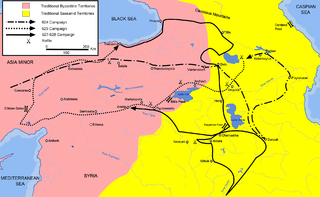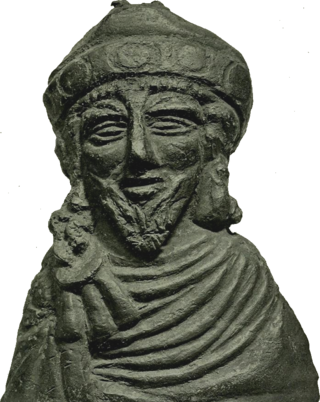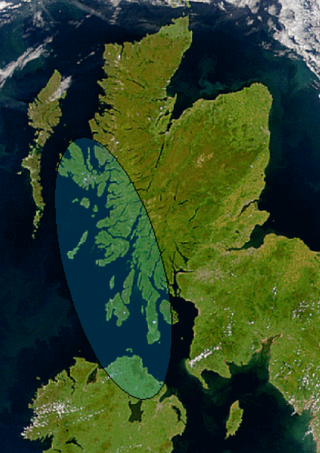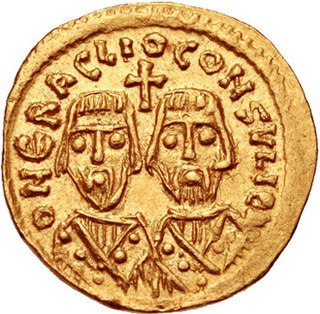The 620s decade ran from January 1, 620, to December 31, 629.
The 610s decade ran from January 1, 610, to December 31, 619.
The 530s decade ran from January 1, 530, to December 31, 539.
The 570s decade ran from January 1, 570, to December 31, 579.

Year 624 (DCXXIV) was a leap year starting on Sunday of the Julian calendar. The denomination 624 for this year has been used since the early medieval period, when the Anno Domini calendar era became the prevalent method in Europe for naming years.

Year 625 (DCXXV) was a common year starting on Tuesday of the Julian calendar. The denomination 625 for this year has been used since the early medieval period, when the Anno Domini calendar era became the prevalent method in Europe for naming years.

Year 627 (DCXXVII) was a common year starting on Thursday of the Julian calendar. The denomination 627 for this year has been used since the early medieval period, when the Anno Domini calendar era became the prevalent method in Europe for naming years.

Year 629 (DCXXIX) was a common year starting on Sunday of the Julian calendar. The denomination 629 for this year has been used since the early medieval period, when the Anno Domini calendar era became the prevalent method in Europe for naming years.

Year 532 (DXXXII) was a leap year starting on Thursday of the Julian calendar. At the time, it was known as the Second year after the Consulship of Lampadius and Probus. The denomination 532 for this year has been used since the early medieval period, when the Anno Domini calendar era became the prevalent method in Europe for naming years.
Year 538 (DXXXVIII) was a common year starting on Friday of the Julian calendar. At the time, it was known as the Year of the Consulship of Iohannes without colleague. The denomination 538 for this year has been used since the early medieval period, when the Anno Domini calendar era became the prevalent method in Europe for naming years.
Year 574 (DLXXIV) was a common year starting on Monday of the Julian calendar. The denomination 574 for this year has been used since the early medieval period, when the Anno Domini calendar era became the prevalent method in Europe for naming years.

Year 610 (DCX) was a common year starting on Thursday of the Julian calendar, the 610th year of the Common Era (CE) and Anno Domini (AD) designations, the 610th year of the 1st millennium, the 10th year of the 7th century, and the 1st year of the 610s decade. The denomination 610 for this year has been used since the early medieval period, when the Anno Domini calendar era became the prevalent method in Europe for naming years.

Year 619 (DCXIX) was a common year starting on Monday of the Julian calendar. The denomination 619 for this year has been used since the early medieval period, when the Anno Domini calendar era became the prevalent method in Europe for naming years.

Year 698 (DCXCVIII) was a common year starting on Tuesday of the Julian calendar. The denomination 698 for this year has been used since the early medieval period, when the Anno Domini calendar era became the prevalent method in Europe for naming years.

Phocas was Eastern Roman emperor from 602 to 610. Initially, a middle-ranking officer in the Eastern Roman army, Phocas rose to prominence as a spokesman for dissatisfied soldiers in their disputes with the court of the Emperor Maurice. When the army revolted in 602, Phocas emerged as the natural leader of the mutiny. The revolt proved to be successful and led to the capture of Constantinople and the overthrow of Maurice on 23 November 602 with Phocas declaring himself emperor on the same day.

Year 575 (DLXXV) was a common year starting on Tuesday of the Julian calendar. The denomination 575 for this year has been used since the early medieval period, when the Anno Domini calendar era became the prevalent method in Europe for naming years.

Áedán mac Gabráin, also written as Aedan, was a king of Dál Riata from c. 574 until c. 609 AD. The kingdom of Dál Riata was situated in modern Argyll and Bute, Scotland, and parts of County Antrim, Ireland. Genealogies record that Áedán was a son of Gabrán mac Domangairt.

Heraclius the Elder was a Byzantine general and the father of Byzantine emperor Heraclius. Generally considered to be of Armenian origin Heraclius the Elder distinguished himself in the war against the Sassanid Persians in the 580s. As a subordinate general, Heraclius served under the command of Philippicus during the Battle of Solachon and possibly served under Comentiolus during the Battle of Sisarbanon. In circa 595, Heraclius the Elder is mentioned as a magister militum per Armeniam sent by Emperor Maurice to quell an Armenian rebellion led by Samuel Vahewuni and Atat Khorkhoruni. In circa 600, he was appointed as the Exarch of Africa and in 608, Heraclius the Elder rebelled with his son against the usurper Phocas. Using North Africa as a base, the younger Heraclius managed to overthrow Phocas, beginning the Heraclian dynasty, which would rule Byzantium for a century. Heraclius the Elder died soon after receiving news of his son's accession to the Byzantine throne.
The 600s decade ran from January 1, 600, to December 31, 609.

The Exarch of Africa Heraclius the Elder and his namesake son Heraclius the Younger began a rebellion against the Byzantine emperor Phocas in 608. In October 610, Heraclius the Younger reached Constantinople, executed Phocas, and was proclaimed as emperor, establishing the Heraclian dynasty of the Byzantine Empire.













